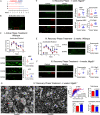N-acetylglucosamine drives myelination by triggering oligodendrocyte precursor cell differentiation
- PMID: 33453988
- PMCID: PMC7762951
- DOI: 10.1074/jbc.RA120.015595
N-acetylglucosamine drives myelination by triggering oligodendrocyte precursor cell differentiation
Abstract
Myelination plays an important role in cognitive development and in demyelinating diseases like multiple sclerosis (MS), where failure of remyelination promotes permanent neuro-axonal damage. Modification of cell surface receptors with branched N-glycans coordinates cell growth and differentiation by controlling glycoprotein clustering, signaling, and endocytosis. GlcNAc is a rate-limiting metabolite for N-glycan branching. Here we report that GlcNAc and N-glycan branching trigger oligodendrogenesis from precursor cells by inhibiting platelet-derived growth factor receptor-α cell endocytosis. Supplying oral GlcNAc to lactating mice drives primary myelination in newborn pups via secretion in breast milk, whereas genetically blocking N-glycan branching markedly inhibits primary myelination. In adult mice with toxin (cuprizone)-induced demyelination, oral GlcNAc prevents neuro-axonal damage by driving myelin repair. In MS patients, endogenous serum GlcNAc levels inversely correlated with imaging measures of demyelination and microstructural damage. Our data identify N-glycan branching and GlcNAc as critical regulators of primary myelination and myelin repair and suggest that oral GlcNAc may be neuroprotective in demyelinating diseases like MS.
Keywords: N-acetylglucosamine; N-glycan branching; N-linked glycosylation; metabolism; multiple sclerosis; myelin; myelin repair; myelination; oligodendrocyte; oligodendrocyte precursor cell; oligodendrocytes.
Copyright © 2020 © 2020 Sy et al. Published by Elsevier Inc. All rights reserved.
Conflict of interest statement
A. U. B., F. P., J. D., and M. D. are named as inventors on a patent that describes GlcNAc as a biomarker for multiple sclerosis. J. D. and M. D. are named as inventors on a patent for use of GlcNAc in multiple sclerosis and were cofounders of Glixis Therapeutics, a company developing analogs of GlcNAc for multiple sclerosis and other autoimmune diseases
Figures




Similar articles
-
N-acetylglucosamine inhibits inflammation and neurodegeneration markers in multiple sclerosis: a mechanistic trial.J Neuroinflammation. 2023 Sep 13;20(1):209. doi: 10.1186/s12974-023-02893-9. J Neuroinflammation. 2023. PMID: 37705084 Free PMC article.
-
Polysialylation at Early Stages of Oligodendrocyte Differentiation Promotes Myelin Repair.J Neurosci. 2017 Aug 23;37(34):8131-8141. doi: 10.1523/JNEUROSCI.1147-17.2017. Epub 2017 Jul 31. J Neurosci. 2017. PMID: 28760868 Free PMC article.
-
rHIgM22 enhances remyelination in the brain of the cuprizone mouse model of demyelination.Neurobiol Dis. 2017 Sep;105:142-155. doi: 10.1016/j.nbd.2017.05.015. Epub 2017 May 30. Neurobiol Dis. 2017. PMID: 28576706
-
Oligodendrocytes in Development, Myelin Generation and Beyond.Cells. 2019 Nov 12;8(11):1424. doi: 10.3390/cells8111424. Cells. 2019. PMID: 31726662 Free PMC article. Review.
-
Mechanisms of remyelination: recent insight from experimental models.Biomol Concepts. 2014 Aug;5(4):289-98. doi: 10.1515/bmc-2014-0015. Biomol Concepts. 2014. PMID: 25372760 Review.
Cited by
-
Exploring serum glycome patterns after moderate to severe traumatic brain injury: A prospective pilot study.EClinicalMedicine. 2022 Jun 17;50:101494. doi: 10.1016/j.eclinm.2022.101494. eCollection 2022 Aug. EClinicalMedicine. 2022. PMID: 35755600 Free PMC article.
-
High-rate mechano-stimulation alters proliferation- and maturation-related signaling of oligodendrocyte precursor cells in a 3D hydrogel.Mechanobiol Med. 2025 Mar 11;3(3):100126. doi: 10.1016/j.mbm.2025.100126. eCollection 2025 Sep. Mechanobiol Med. 2025. PMID: 40519865 Free PMC article.
-
Oligodendroglial Energy Metabolism and (re)Myelination.Life (Basel). 2021 Mar 13;11(3):238. doi: 10.3390/life11030238. Life (Basel). 2021. PMID: 33805670 Free PMC article. Review.
-
Symptomatic and restorative therapies in neuromyelitis optica spectrum disorders.J Neurol. 2022 Apr;269(4):1786-1801. doi: 10.1007/s00415-021-10783-4. Epub 2021 Sep 5. J Neurol. 2022. PMID: 34482456 Free PMC article. Review.
-
Hexosamine pathway activation improves memory but does not extend lifespan in mice.Aging Cell. 2022 Oct;21(10):e13711. doi: 10.1111/acel.13711. Epub 2022 Sep 19. Aging Cell. 2022. PMID: 36124412 Free PMC article.
References
-
- Lee Y., Morrison B. M., Li Y., Lengacher S., Farah M. H., Hoffman P. N., Liu Y., Tsingalia A., Jin L., Zhang P. W., Pellerin L., Magistretti P. J., and Rothstein J. D. (2012) Oligodendroglia metabolically support axons and contribute to neurodegeneration. Nature 487, 443–448 10.1038/nature11314 - DOI - PMC - PubMed
-
- Fünfschilling U., Supplie L. M., Mahad D., Boretius S., Saab A. S., Edgar J., Brinkmann B. G., Kassmann C. M., Tzvetanova I. D., Möbius W., Diaz F., Meijer D., Suter U., Hamprecht B., Sereda M. W., et al. (2012) Glycolytic oligodendrocytes maintain myelin and long-term axonal integrity. Nature 485, 517–521 10.1038/nature11007 - DOI - PMC - PubMed
-
- Mei F., Lehmann-Horn K., Shen Y.-A. A., Rankin K. A., Stebbins K. J., Lorrain D. S., Pekarek K., A Sagan S., Xiao L., Teuscher C., von Büdingen H.-C., Wess J., Lawrence J. J., Green A. J., Fancy S. P., et al. (2016) Accelerated remyelination during inflammatory demyelination prevents axonal loss and improves functional recovery. eLife 5, 10.7554/eLife.18246 - DOI - PMC - PubMed
Publication types
MeSH terms
Substances
Grants and funding
LinkOut - more resources
Full Text Sources
Other Literature Sources
Molecular Biology Databases

